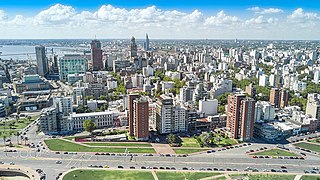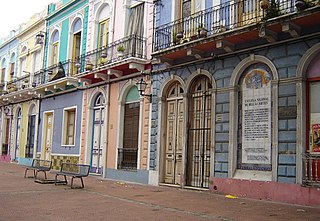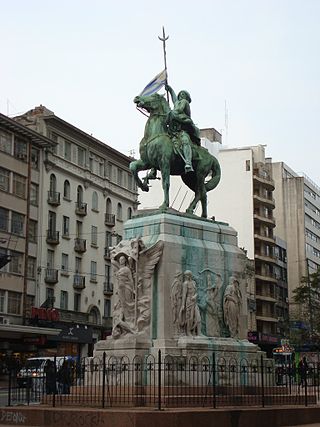
Montevideo is the capital and largest city of Uruguay. According to the 2011 census, the city proper has a population of 1,319,108 in an area of 201 square kilometers (78 sq mi). Montevideo is situated on the southern coast of the country, on the northeastern bank of the Río de la Plata.

The General Assembly of Uruguay or parliament is the legislative branch of the government of Uruguay, and consists of two chambers: the Chamber of Senators and the Chamber of Representatives. General Assembly has 130 voting members: 99 representatives and 30 senators, the Vice President of the Republic, who serves as President of the General Assembly, and the Senate has the right to vote. The legislature meets in the Legislative Palace in Montevideo. Both senators and representatives are chosen through proportional representation for five-year terms.

Centro is a barrio of Montevideo, Uruguay. Its main axis is 18 de Julio Avenue, and it runs between Plaza Independencia and Ejido St, being the central business district.

Plaza Independencia is the most important city square in Montevideo, Uruguay, laid out in the 19th century in the area occupied by the Citadel of Montevideo. In its center is a monument to General José Gervasio Artigas, and below it, his mausoleum.

The Legislative Palace of Uruguay is a monumental building, meeting place of the General Assembly of Uruguay, and the seat of the legislative branch of the Uruguayan government. It is located in the barrio of Aguada in the city of Montevideo.

Ope Pasquet Iribarne is a Uruguayan lawyer and politician of the Colorado Party.

The president of Uruguay, officially known as the president of the Oriental Republic of Uruguay, is the head of state and head of government of Uruguay. Their rights are determined in the Constitution of Uruguay. Along with the Secretariat of the Presidency, the Council of Ministers and the director of the Office of Planning and Budget, the President is part of the executive branch. In case of absence, their office is exercised by the vice president. In turn, the president of the republic is the commander in chief of the Armed Forces.

Villa Muñoz - Retiro is a barrio of Montevideo, Uruguay, bordering Aguada and Reducto to the west, La Figurita to the north, La Comercial to the east and Cordón to the south.

Cordón is a central barrio of Montevideo, Uruguay, located East of the Centro. Its main avenue is 18 de Julio Avenue.

Punta Carretas is a barrio of Montevideo, Uruguay.

Plaza de Cagancha is a public square in barrio Centro of Montevideo, Uruguay. Located on 18 de Julio Avenue, the main avenue of the city, it originated in 1836 as the central space of the layout of the "Ciudad Nueva", outside the limits of the walled area of the colonial period.

Libertador Avenue is a major avenue in Montevideo, Uruguay. It stretches north from the Legislative Palace in Aguada to Plaza Fabini in Centro, and is named after Juan Antonio Lavalleja, revolutionary figure and politician, who led the group of the Thirty-Three Orientals in the insurrection for the independence of Oriental Province.

The Supreme Court of Uruguay is the highest court of law and last resort in the Oriental Republic of Uruguay. It serves as the highest appeals court, and appoints and oversees all other judges. Established on 28 October 1907, it is housed in the Palacio Piria, a masterpiece of eclectic architecture from 1917.
Camille Remy Alexandre Gardelle was a French architect.

The Aarón de Anchorena National Park is a park and rest residence of the President of Uruguay. It is located in the Colonia Department, in southwestern Uruguay, 208 kilometers from Montevideo. It was donated by the Argentine farmer Aarón de Anchorena to the Uruguayan state.

María Olga Piria de Jaureguay was a Uruguayan artist, pianist and goldsmith, who was a pupil of Joaquín Torres García.

Mónica Bottero Tovagliare is a Uruguayan journalist, writer and politician from the Independent Party (PI).
Doris Perla Morales Martínez is a Uruguayan lawyer who serves as a minister of the Supreme Court of Uruguay.

Democracy Square is a road junction and public space in barrio Tres Cruces of Montevideo, Uruguay.























